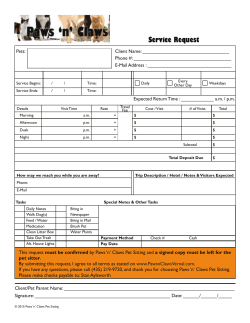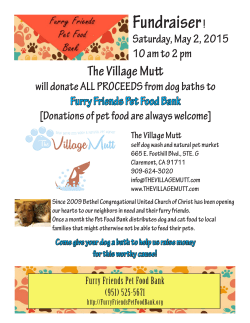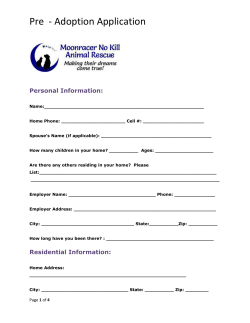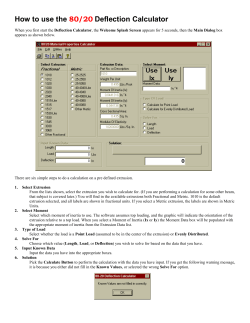
Critical issues to reduce the cost of extrusion and drying
XIV Congresso CBNA PET 2015 25 e 26 de março de 2015 – Ribeirão Preto, SP Critical issues to reduce the cost of extrusion and drying processes Brian Streit Dir. of Pet Food & Aquatic Tech. Wenger Manufacturing, Inc. Processing Cost Reduction is a Complex Equation Direct Cost Control Variables • Formulation design and finished product spec’s Nutrient targets Unique ingredient and fresh meat inclusion Density, shape, size • Raw material quality and blended ration variation Moisture Grind size and coefficient of variation • Processing technique and hardware Thermal vs. Mechanical Preconditioner design, single screw or twin, control devices Dryer design, condition, and operating parameters Indirect Cost Control Variables • Resource planning and production scheduling Efficiency Production run length • Change-over times Milling Extrusion • Predictive and preventative maintenance programs • Quality programs and demands Daily clean breaks, hold and release, and lot definition Cleaning and sanitation Processing Cost Reduction is a Complex Equation SO……”What is in my control?” Critical Variables to Control • Dry ration variability and particle size • Extrusion processing technique • Drying system optimization • Production planning • Communication and coordination with maintenance and sanitation • Process auditing and continuous improvement programs XIV Congresso CBNA PET 2015 25 e 26 de março de 2015 – Ribeirão Preto, SP Ration Variability and Grind Size • Target batch mixer coefficient of variation <10% • No particle to exceed 1.5 mm (1/16”) Results in…. Greater ease of cooking Reduced product breakage and fines Higher throughputs for given extruder and preconditioner Less wear on extruder components for a given rate Improved product appearance Reduced incidence of die orifices plugging Extruder Process Efficiency • It takes a certain level of energy to create a given product via extrusion • Thermal and mechanical energy are the major sources of energy in the extrusion process • What are the effects of changing the ratio of mechanical to thermal energy? 1st Law of Thermodynamics = “Energy can be changed from one form to another, but it cannot be created nor destroyed.” Average Energy and Wear Costs • Thermal energy costs = $7.32 / million kJ • Mechanical energy costs = $18.06 / million kJ • Wear costs = $1.25/ton for every 22 kW-hr/ton SME Energy Contributions Typical Pet Food Extrusion Process XIV Congresso CBNA PET 2015 25 e 26 de março de 2015 – Ribeirão Preto, SP Guide for Controlling Mechanical to Thermal Energy Ratio • High Intensity Preconditioner technology Maximize steam inclusion Optimize mixing CV = 2.65 • Thermal twin extrusion technology – allows for significantly higher levels of steam inclusion • Utilization of variable speed extruder to optimize mechanical energy to formulation • Finely ground dry ration = 100% through a 400 micron screen • Well maintained process equipment Dryer process optimization Drying Time Shorter Retention Times (1 min. – 30 min.) Roasting / Toasting Drying Longer Retention Times (30 min. – 6 hrs.) Dehydrating Baking Drying time directly controls product Bed Depth Shorter time – decreases bed depth (thinner) Longer time – increases bed depth (deeper) Drying Time Adjustment XIV Congresso CBNA PET 2015 25 e 26 de março de 2015 – Ribeirão Preto, SP Temperature and Airflow may need to be adjusted to achieve final product target. Drying Temperature Used to “FINE TUNE” product moistures Lower Temperatures ( 70° F – 250° F ) Drying Dehydrating Higher Temperatures ( 250° F - 600° F ) Roasting / Toasting Baking Temperature too High Burnt or Scorched Brittle Product Case Hardening (mold internally) Temperature too Low Not Dry Chewy Product Short Shelf Life (stale or mold) Product Cooling 1) Eliminate moisture condensation during storage 80C air - holds 616 g water / kg dry air 20C air - holds 15 g water / kg dry air 2) Typically cool 5 - 7C above storage temperature 3) High ambient temperature Mechanically cool process air Airflow 1) Last variable to be adjusted 2) Most important factor – Air Through Product Bed Too much Airflow Blow product around Short circuit air Product not dry XIV Congresso CBNA PET 2015 25 e 26 de março de 2015 – Ribeirão Preto, SP Not enough Airflow Product clumps Uneven drying Product not dry Dryer Bed Depth Bed Depths directly affect Airflow Bed Depth limitations Soft or fragile products Sticky products Extremely wet products Product bulk density Product size Dryer Spreading Most underestimated factor!! Spreading directly affects Airflow! Results from uneven spreading Moisture variations in final product Excessive fines in dryer (low density products) Dryer Moisture Uniformity XIV Congresso CBNA PET 2015 25 e 26 de março de 2015 – Ribeirão Preto, SP Production Scheduling • Milling process considerations Screen changing – run product types back to back Raw material delivery • Product specific production sequencing Export requirements Organic Specialty product • Extrusion process considerations Die size and shape Product running prior to a shutdown for cleaning and maintenance Communication and Coordination • Scheduled downtime coordination and preparation XIV Congresso CBNA PET 2015 25 e 26 de março de 2015 – Ribeirão Preto, SP • • • What are we working on, cleaning, etc. What parts, tools, cleaning utensils, etc. are required What human resources are required Last product run before shutdown – will that impact cleaning or maintenance time??? Develop a team approach with maintenance and sanitation What is the value of efficiency and time - $$$ Continuous Improvement Programs • Process Auditing Evaluation of each individual process Set parameters for control Measure against those metrics Audit and Reset • Evaluation of how to clean and maintain to reduce downtime Milling Extrusion • Utilize 3rd party auditing for support Specific expertise Fresh set of eyes Cost Reduction Summary • Grind size and CV key control point in milling • Manage your process to more thermal than mechanical energy where possible • Train operators on the dryer operation and appropriate changes • Operational efficiency is more than just equipment optimization Production planning and communication is key Perform process audits and develop live action plans • Make processing adjustments one step at a time ~ evaluate and adjust Thank You!!! Brian Streit Dir. of Pet Food & Aquatic Tech. Wenger Manufacturing, Inc. www.wenger.com bstreit@wenger.com
© Copyright 2025










